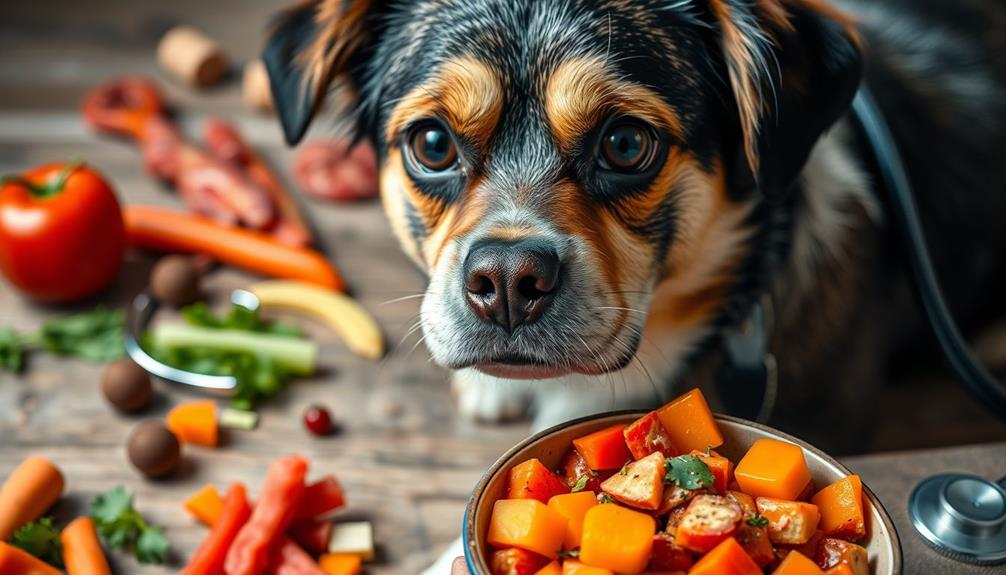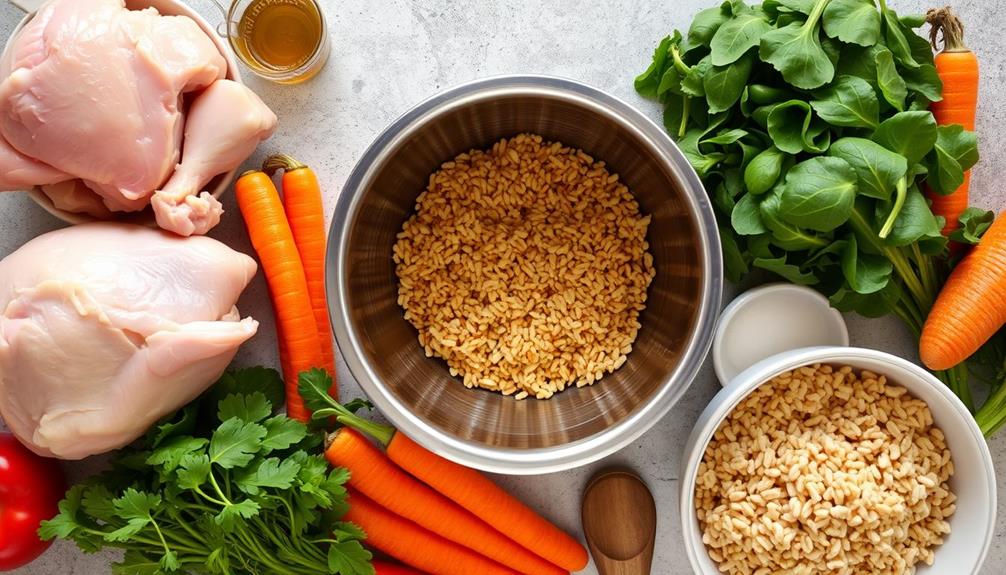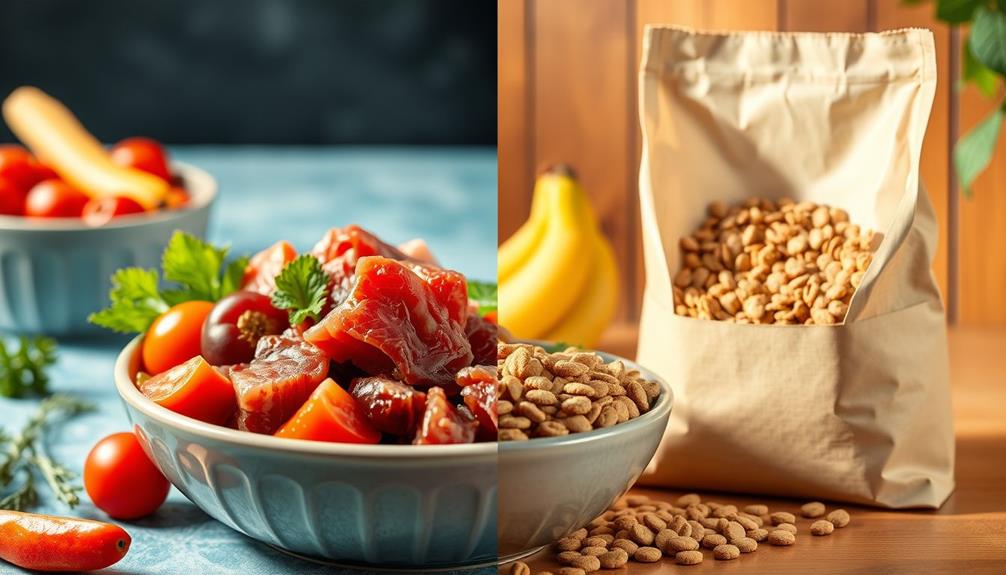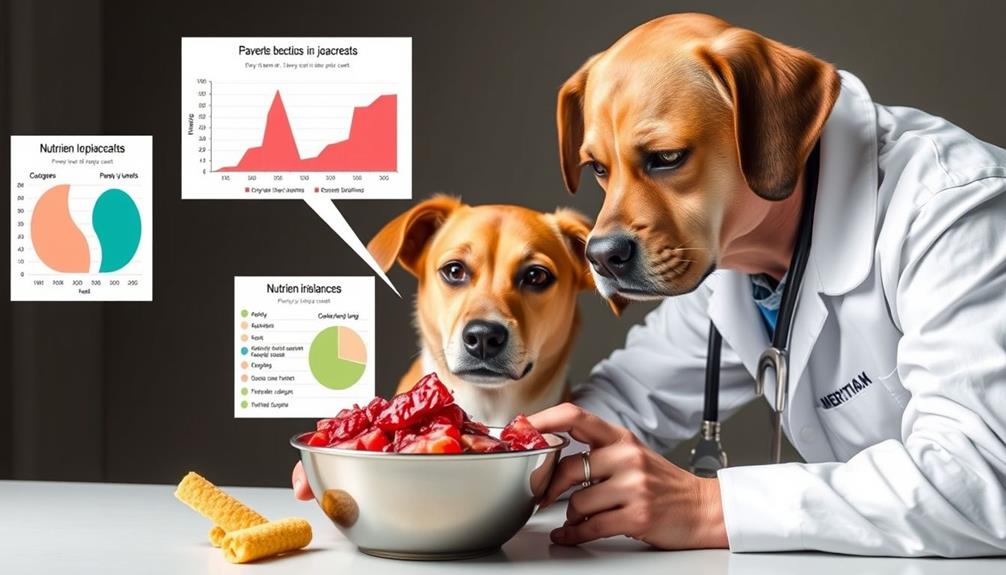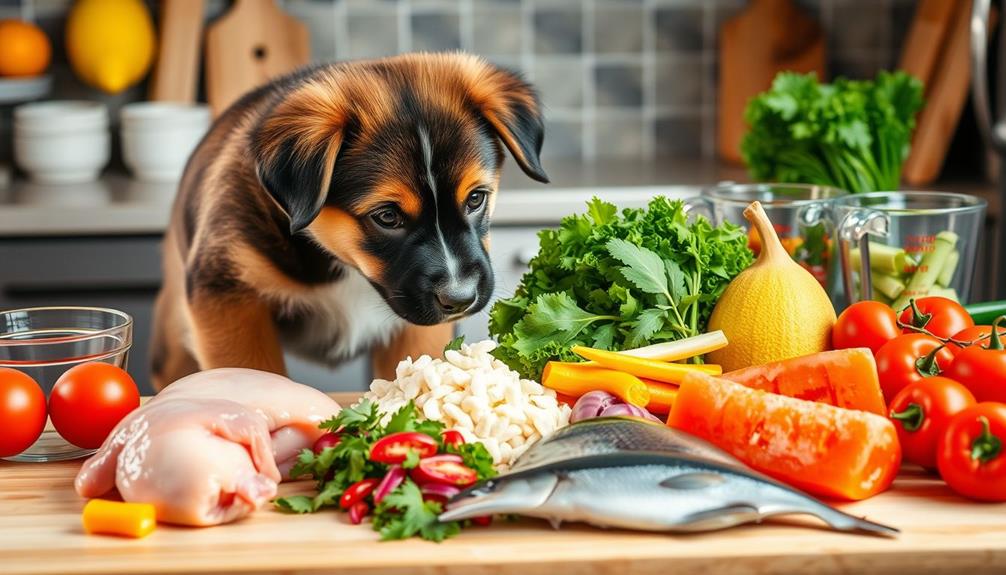Yes, dogs can be allergic to raw food, particularly to proteins like chicken, beef, or lamb. Symptoms often include itchy skin, excessive scratching, hair loss, and gastrointestinal issues such as vomiting and diarrhea. These allergies can develop over time with repeated exposure to specific ingredients. Identifying the offending protein through dietary trials is essential for effective treatment. Once you pinpoint the allergen, you can adjust your dog's diet to promote healing and prevent future issues. You'll discover further details on how to manage these allergies effectively. Additionally, it’s important to consult with a veterinarian to ensure proper diagnosis and treatment for raw dog food allergies. They can provide guidance on alternative protein sources and help formulate a well-balanced diet for your pup. It’s also crucial to read product labels carefully and avoid any potential allergens when selecting raw food for your dog. Taking these steps can help alleviate symptoms and improve your dog’s overall health and well-being.
Key Takeaways
- Dogs can develop allergies to raw food proteins, including common sources like chicken, beef, and lamb, often due to repeated exposure.
- Symptoms of raw food allergies include itchy skin, gastrointestinal issues, and changes in skin pigmentation, indicating potential underlying problems.
- Diagnosing allergies involves dietary trials, thorough history, and tests to identify specific allergens, requiring at least 90 days of elimination.
- Treatment focuses on removing allergens, adjusting the diet, and may include antihistamines for temporary relief, but consulting a vet is essential.
- Strong immune health through balanced diets and regular monitoring helps manage and mitigate the effects of food allergies in dogs.
Understanding Raw Food Allergies
Raw food allergies in dogs can be a perplexing issue for pet owners. Some dogs might develop allergies to proteins commonly found in a raw food diet, such as chicken, beef, lamb, and dairy products.
These allergies can strain your dog's immune system, leading to various health complications. It's vital to monitor your dog's overall health and nutrition, as improper dietary choices can exacerbate these allergies and contribute to other issues, including cold medications overview.
You may notice that your dog shows symptoms like skin rashes, itching, hair loss, or gastrointestinal issues, including vomiting and diarrhea. Allergies can develop over time due to repeated exposure to certain food proteins, and some dogs could be genetically predisposed to these reactions.
Diagnosing raw food allergies typically involves food elimination trials, which require your commitment for at least 90 days. This period allows you to accurately observe how your dog responds to dietary changes and helps identify specific allergens.
To manage these allergies holistically, focus on identifying and removing allergens from your dog's diet. Regular veterinary check-ups are also significant for monitoring your dog's health and adjusting the diet as needed.
Symptoms of Raw Food Allergies
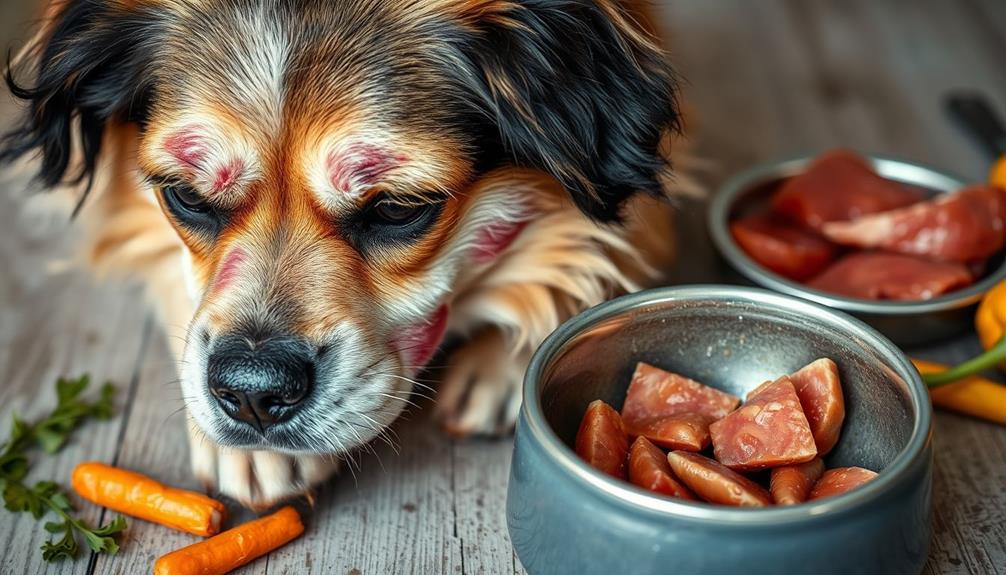
When your dog suffers from raw food allergies, you might notice a variety of concerning symptoms. One of the most common signs is itchy skin, which can lead to excessive scratching and hair loss, especially on their paws.
Allergic reactions can also manifest through red, watery eyes and sore or scaly skin. Additionally, providing healthy dog snacks made from natural ingredients can help support your dog's overall skin health. You may observe changes in skin pigmentation, indicating an underlying issue.
Gastrointestinal problems are another red flag. If your dog experiences vomiting or diarrhea after eating raw food, it could be a sign of an allergy. It's important to monitor these symptoms closely, as reactions can vary in severity and may develop over time with repeated exposure to specific allergens, like proteins from chicken, beef, lamb, or dairy products.
Keep in mind that up to 20% of dogs worldwide may experience allergies, making awareness essential for responsible pet ownership.
If you notice symptoms appear, consult your veterinarian for guidance. Early detection and intervention can help guarantee your dog's well-being and comfort, preventing further complications associated with raw food allergies.
Diagnosing Raw Food Allergies
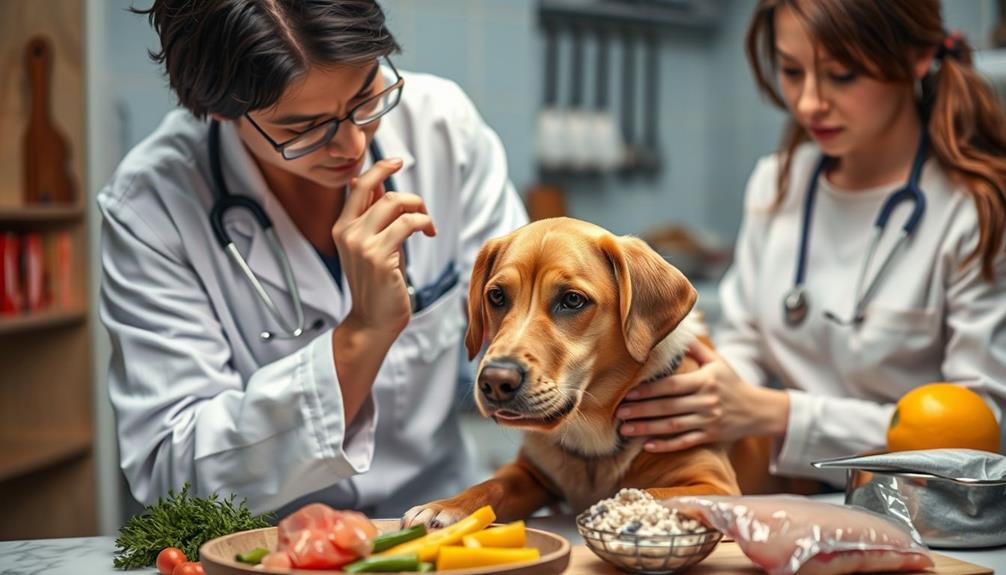
Identifying raw food allergies in dogs requires a systematic approach to pinpoint the specific triggers causing your pet's discomfort. Diagnosing these allergies often starts with a thorough history and dietary analysis, along with skin examinations and parasite checks by veterinarians.
| Diagnostic Method | Description | Duration |
|---|---|---|
| Dietary Trials | Eliminate potential allergens and observe | At least 90 days |
| Blood Tests | CBC and chemistry panel to assess health | Immediate results |
| Alternative Testing | Methods like Bicom testing for allergies | Varies by practice |
Monitoring allergy symptoms is vital, as reactions can develop quickly or over time. This means keeping a close eye on any changes in your dog's behavior or health after dietary adjustments. Additionally, it is important to evaluate potential environmental allergens, as they can complicate diagnosing food allergies.
Veterinary practices will guide you through this process, ensuring that you have all the necessary information to make informed decisions for your dog's raw diet. By following these steps, you'll be well-equipped to identify and address your dog's food allergies effectively.
Treatment Options for Allergies
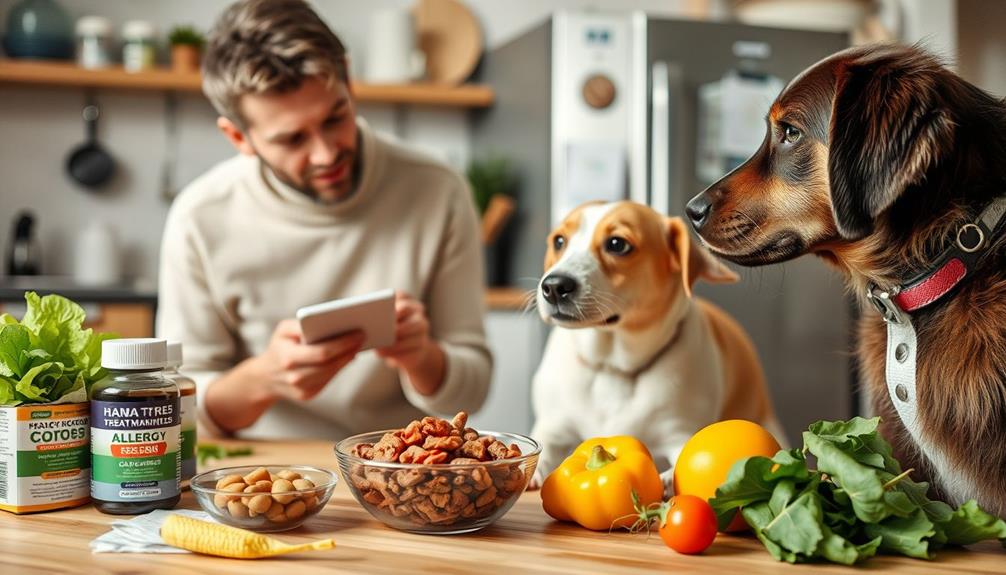
Finding the right treatment options for your dog's food allergies can bring relief and improve their quality of life. The first step is identifying and removing specific allergens from your dog's diet. This process may require dietary trials lasting up to 90 days, which is vital for long-term relief from allergic reactions.
Additionally, maintaining a diet free from high-sugar or high-fat foods can further support your dog's health, as it's important to monitor what they eat closely routine health checks for signs of illness.
While medications like antihistamines can provide temporary relief from itching and scratching, they don't address the underlying cause of food allergies. You might consider natural balms or anti-itch ointments to complement these medications, but remember that ongoing exposure to allergens can lead to recurring skin conditions.
Regular monitoring of your dog's symptoms after any dietary or environmental changes is necessary to guarantee your treatment plan remains effective.
It's also essential to consult with a veterinarian for tailored dietary advice. They can help you develop a strict dietary control plan once allergens are identified, guaranteeing your dog's diet is safe and healthy.
Recovery and Long-term Management
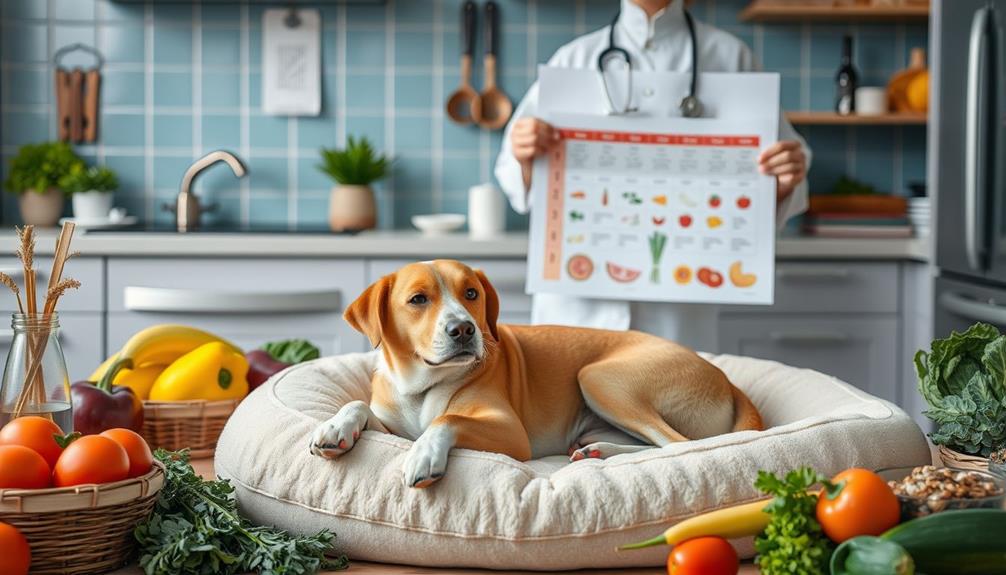
Once you've identified your dog's allergens, it's essential to adjust their diet accordingly to promote healing.
Implementing a clear budget for your pet's nutritional needs can help guarantee you're making informed choices about their food, similar to how you'd manage your personal budget.
Ongoing health monitoring will help you track any changes or improvements, making sure your furry friend stays on the right path.
Allergen Identification Process
As you begin the allergen identification process for your dog, it is essential to understand that this journey requires careful planning and commitment. The first step involves a detailed dietary history and a food elimination trial lasting at least 90 days. This period helps you accurately assess your dog's reactions to specific allergens.
During this process, veterinarians may perform various tests, including blood tests and skin examinations, to pinpoint the allergens affecting your dog's immune system. Once identified, strict dietary control is necessary to prevent ongoing allergic reactions. Continuous exposure can lead to recurring symptoms, complicating recovery.
To help you visualize the key steps in the identification process, here's a table:
| Step | Description |
|---|---|
| Dietary History | Review your dog's food intake and symptoms. |
| Elimination Trial | Remove potential allergens for at least 90 days. |
| Testing | Conduct blood tests and skin exams as needed. |
| Dietary Control | Implement strict dietary measures post-identification. |
Regular monitoring of your dog's health is critical for effective long-term management of food allergies. Consulting with a veterinarian guarantees tailored advice for ideal recovery.
Dietary Adjustment Strategies
To effectively manage your dog's raw food allergies, it's important to implement dietary adjustment strategies that focus on both recovery and long-term health. Understanding the significance of long-term financial planning for your pet's health can also play a role in managing allergies and associated treatments.
Start by identifying and removing specific allergens from their diet, as strict dietary control is fundamental to prevent recurring allergic reactions. A 90-day dietary trial can help you accurately assess your dog's response to a new diet and determine the presence of any allergies end-of-life care options.
Consulting with a veterinarian is critical; they can guide you through food exclusion trials and recommend alternative nutrition plans tailored to your dog's needs. During the recovery process, consider incorporating natural supplements and anti-itch treatments to support your dog's healthy immune system, but remember these shouldn't replace the need to eliminate allergens.
Regularly monitor your dog's health after making dietary adjustments. This ongoing vigilance is key to ensuring long-term recovery and addressing any emerging issues.
Ongoing Health Monitoring
Monitoring your dog's health closely after dietary adjustments is essential for guaranteeing a successful recovery from raw food allergies. Ongoing health monitoring helps you track the effectiveness of the changes you've made and prevents the re-emergence of symptoms.
Regular veterinary check-ups are fundamental to assess your dog's overall health and identify any signs of nutritional deficiencies that may arise from dietary changes, particularly since critical periods identified for skill acquisition and learning can also apply to dietary habits and digestion in dogs.
Keeping a detailed log of your dog's diet and any symptom fluctuations is invaluable. This record can aid both you and your veterinarian in making informed decisions for ongoing management. After removing specific allergens, periodically reassessing your dog's diet is crucial to guarantee it remains balanced and supports their immune system.
Additionally, maintaining a consistent feeding schedule is important for your dog's health. Always be vigilant for any new symptoms that could indicate additional allergies or intolerances, as dogs can develop new sensitivities over time.
Environmental Factors and Allergies
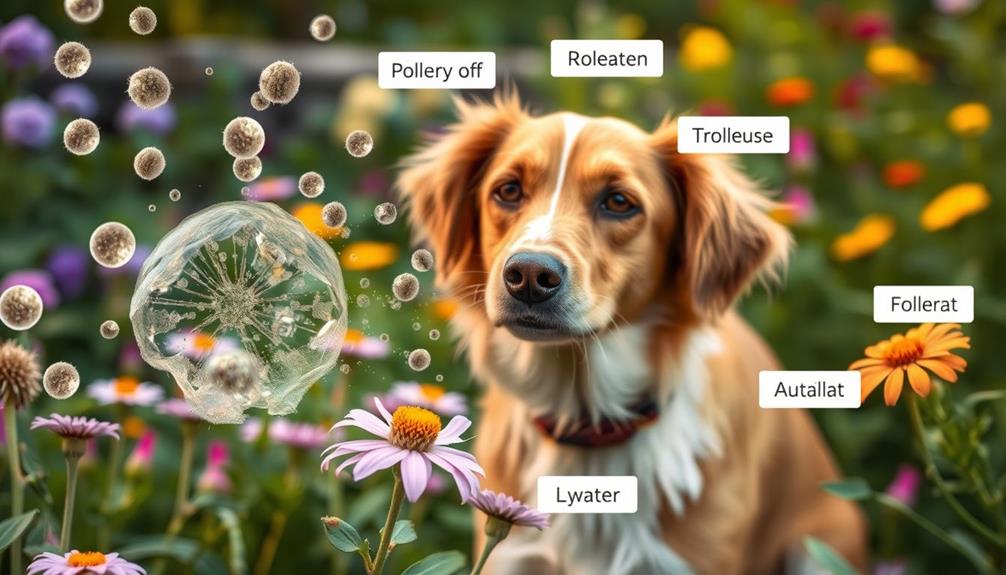
You mightn't realize how much common environmental allergens can affect your dog's health. Things like pollen, dust, and even flea saliva can trigger allergic reactions and complicate the process of identifying food allergies.
Understanding the causes and risk factors related to allergies can be essential in determining the best course of action for your dog. By understanding these impacts, you can better manage your dog's exposure and support their immune system.
Common Environmental Allergens
Many dogs face challenges from common environmental allergens that can trigger allergic reactions and discomfort. Pollen, mold spores, dust mites, and dander are frequent culprits that can lead to an immune response in sensitive dogs. As seasons change, you might notice your dog experiencing heightened symptoms, especially if they're prone to allergies.
Additionally, maintaining a balanced diet and regular exercise can help strengthen your dog's immune system, making them less susceptible to allergic reactions. Flea saliva is another significant environmental trigger that can cause immediate allergic reactions, resulting in intense itching and skin irritation.
When your dog encounters these allergens, it can disrupt the balance of healthy bacteria on their skin, leading to further complications. It's not uncommon for dogs to suffer from multiple allergies simultaneously, making diagnosis tricky. Both food and environmental allergens can contribute to symptoms, complicating treatment options.
Chronic exposure to these environmental allergens can lead to conditions like ear infections and persistent skin irritations. Because of this, it's crucial to evaluate and manage your dog's exposure to these triggers with the help of a veterinarian.
Identifying the specific allergens affecting your dog can help you develop a more effective treatment plan and improve their overall quality of life. Consider incorporating stress management techniques to support your dog's well-being amidst these challenges.
Impact on Immune System
Environmental factors can markedly impact a dog's immune system, particularly when it comes to allergies. If your dog is frequently exposed to environmental allergens like pollen, mold, and dust, their immune system may become sensitized.
This heightened sensitivity can lead to increased susceptibility to food allergies, including reactions to raw diets. When a dog has prior exposure to these allergens, their immune system may develop exaggerated responses to proteins found in raw food, potentially resulting in allergic reactions.
Additionally, certain essential oils, such as eucalyptus oil known for its decongestant effects, may support respiratory health and overall wellness, which can be beneficial for dogs facing allergy challenges.
Genetic predisposition also plays a role; some breeds are more prone to developing allergies than others. Chronic exposure to environmental allergens can weaken your dog's immune system over time, making them more likely to react negatively to raw food proteins.
To combat these issues, maintaining a healthy immune system is vital. A balanced diet rich in quality ingredients can help mitigate the impact of environmental factors on allergy development.
Alternatives to Raw Feeding
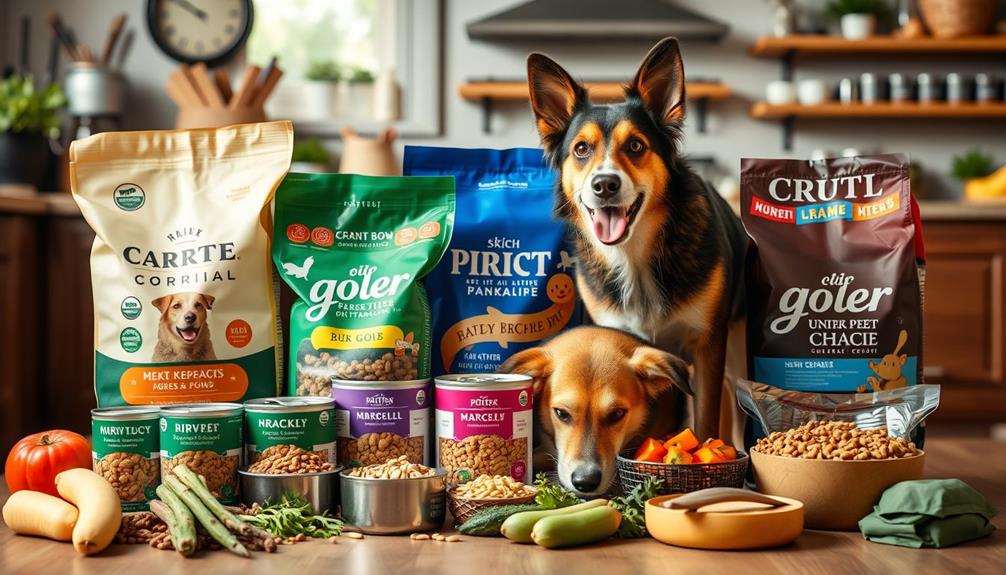
When considering alternatives to raw feeding, it's vital to explore nutritionally complete diets that can provide balanced nutrition while minimizing the risk of allergies. Many commercial dog foods are formulated to avoid common allergens found in raw diets, ensuring your dog gets the nutrients they need without triggering sensitivities.
| Diet Type | Key Features |
|---|---|
| High-Quality Kibble | Balanced nutrition, avoids common allergens |
| Novel Protein Sources | Options like black soldier fly larvae for digestibility |
| Grain-Free Options | Tailored for dogs that struggle with grains |
| Prebiotic-Enriched | Supports gut health and immune function |
| Probiotic-Infused | Enhances digestive balance and overall well-being |
Transitioning to a new diet may take time and experimentation to identify what works best for your dog. Incorporating novel protein sources and grain-free options can help manage food sensitivities. Additionally, including prebiotics and probiotics supports digestive health, making them essential components of a balanced diet. By carefully selecting alternatives to raw feeding, you can help alleviate allergic symptoms while maintaining your dog's overall health.
Frequently Asked Questions
How Do I Know if My Dogs Has Gotten Sick off Raw Food?
If your dog shows signs like vomiting, diarrhea, or excessive itching after eating raw food, it's essential to monitor their behavior and stool. If symptoms persist, consult a veterinarian for proper evaluation and guidance.
How Do You Figure Out What Your Dog Is Allergic to in Food?
Imagine your dog scratching relentlessly, discomfort painted across its face. To identify food allergies, you'll need to track their diet meticulously, conduct elimination trials, and consult your vet for precise diagnosis and guidance.
What Are the Side Effects of Raw Dog Food?
When you switch to raw dog food, your pup might face side effects like vomiting, diarrhea, or skin issues. It's essential to monitor their reaction and consult a vet if symptoms persist or worsen.
Can Some Dogs Not Tolerate Raw Food?
Did you know that around 20% of dogs might struggle with certain foods? If your dog shows signs like itching or upset stomach, it's possible they can't tolerate raw food, and you should consider a dietary change.
Conclusion
In summary, while dogs can be allergic to raw food, understanding the symptoms and seeking proper diagnosis is key. Remember, "an ounce of prevention is worth a pound of cure." By addressing allergies early and exploring alternative diets, you can help your furry friend thrive. Keep a close eye on their reactions to food and consult your vet for tailored advice. With the right approach, you can guarantee your dog enjoys a healthy, happy life.

